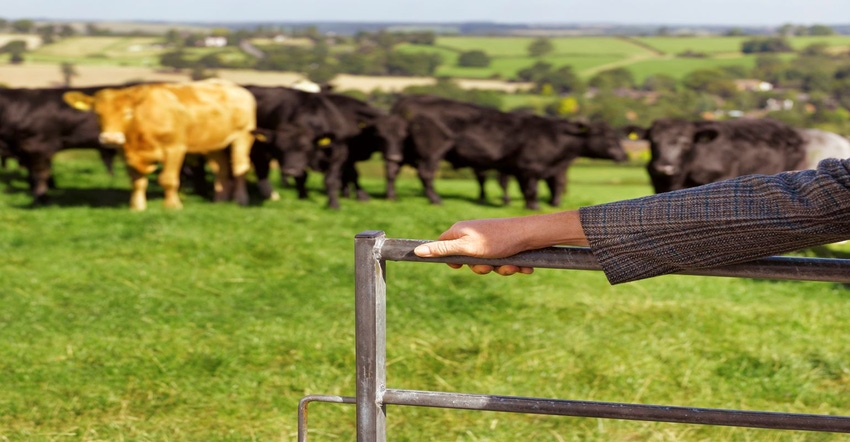Veterinarians share thoughts and 3 tips.
April 25, 2023

Aiming to make the most of spring processing efforts this year?
“Low stress handling presents a domino effect. By minimizing handling stress, you will see improvements in immune response, eating and producing. Calves go back to eating and gaining weight. Cows go back to eating and growing their calf. And, cattle respond better to vaccines,” says Julia Herman, beef cattle specialist veterinarian with the National Cattlemen's Beef Association (NCBA).
Defining Low-stress Handling
For anyone unfamiliar with the term and practice, “Low-stress handling is one part of stockmanship that incorporates the understanding of cattle’s natural behaviors and the handler using that knowledge to positively affect cattle movement and management. It’s responding to their movement, anticipating what the animal will do next,” says Dr. Herman. The Beef Quality Assurance (BQA) program teaches about this principle in preventing stress and disease in cattle, which improves cattle welfare and productivity.
While the practice of excellent stockmanship may have been brought more to the forefront in recent years, the skills are something that have, often, been passed down through generations of family ranches.
Dr. Herman remembers watching her husband and his dad work cattle years ago. “It was like magic,” she said. “They could sort cattle without making a sound. I think there are families where this level of stockmanship has been passed down from generation to generation, and it's taken a couple of high-profile people, like Temple Grandin and Bud Williams, to really bring low-stress handling and stockmanship to the forefront. They have been really good champions of that type of handling.”
The Benefits of Practicing It
When we are stressed, we’re more likely to succumb to a cold or change in behavior. The same rings true for cattle – they can experience health implications and even become moody – and the impacts can stem generations.
Tony Hawkins, Valley Vet Supply technical services veterinarian shared how, “Anything we could do to minimize stress in these animals is good – one, because of animal husbandry and two, because it will actually improve their response to vaccines. Low-stress handling is good for you, and it’s good for them.”
Long thought to be true, science has confirmed how cattle handling directly affects cattle behavior, in addition to health.
Interestingly, low-stress handling methods impact mothering behavior of today, plus the growth and behavior of her future offspring. Dr. Herman explained more, saying “We’re learning more about mothering behavior and how minimizing stress, such as practicing low-stress handling with the dam, in addition to her genetics, can impact multiple generations of animals. That’s because stress hormones circulate throughout the blood system. If you’re following good stockmanship, the heifer will have a better attitude and be calmer in stressful situations, and that can follow down lines. Good-behavior cows can pass that behavior on to multiple generations. I think people have known that, but we're finally getting scientific proof of that.”
3 Tips to Implement When Working Cattle
Take advantage of their flight zones to move cattle. Picture an imaginary oval around a single animal; your placement encourages them to start or stop movement. Dr. Herman explained more, saying, “When you enter the animal’s (or group’s) flight zone, it encourages forward movement. When you retreat from the flight zone, it signals the animal to stop moving. These concepts can be used whether you are handling cattle on foot, horseback, in a vehicle, or when the cattle are in a chute. If we provide good directions to handlers and the cattle through low-stress handling, we improve how the animals respond during handling events.”
When working cattle and you see a hiccup, it’s OK to pause, take a minute and investigate. If you notice cattle are no longer moving smoothly through a specific part of the facility, pause and investigate the hold-up. Dr. Hawkins stressed that, “Really importantly, producers need to think about the design of their facility, and overall quality of the facility, because that plays a big role in how these animals move.”
Prioritize training, and have the right people for the right job. Dr. Herman says, “I think that a huge thing is making sure that our people are trained in the jobs that we are expecting them to do. Stockmanship training creates confidence in our caretakers and improves human safety around cattle. Also, it’s important to be open to changing roles of people during processing events, so that they feel more comfortable and effective. Maybe someone is pushing cows but would rather give vaccines, or vice versa. And when they get tired, maybe we need to switch people out every couple of hours.” This will improve the human’s experience which will also improve the cattle’s experience.
At the end of the day, Dr. Herman asks, “What can the producer control? They can control the products they’re using, the facility they’re running animals through, and they can control how they are handling the animals going through it – all to set that cow or calf up for a positive experience and the most productive life possible.”
Education, resources and training are easily accessible for producers, to help further steward the industry we’re all passionate about.
“There's a lot of training available online that covers stockmanship, cattle health and more, and I would recommend that everybody take advantage of that. It's free and available at BQA.org,” says Dr Hawkins.
Source: Valley Vet Supply
You May Also Like



